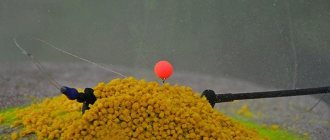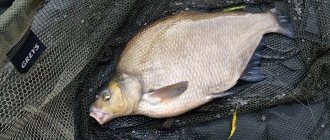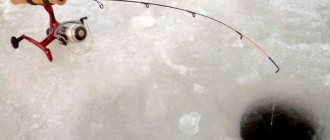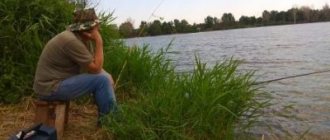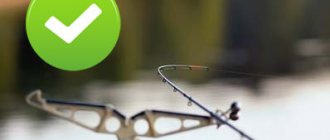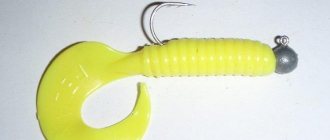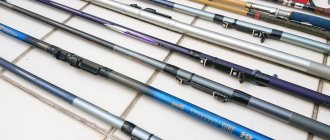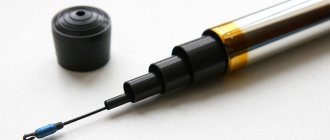Skip to content All about fishing
What, how, when and where to catch
Home » Articles
admin
Fishing for carp using the flat method is especially exciting and has its own characteristics. For fishing to be successful, you need to understand the details of this method.
The highlight of the flat method is the design of the feeder, which allows you to deliver complementary food to the bottom of the reservoir in a precisely chosen place, compactly, as if on a silver platter. This is due to the flat shape of the product with a base made of metal with the properties of lead, and the food is located on top of the plate among holding devices in the form of arcs, partitions and protrusions.
When loaded, the feeder resembles a lying egg, and a hook on a short leash with a nozzle can be placed inside the feed.
Snap method dignity
Let's first figure out what the actual advantages of this equipment are over other feeder installations :
- First of all, this is an opportunity to fish in reservoirs where the bottom is dotted with a fairly thick ball of silt or a lot of aquatic vegetation. Here it’s all about the “flat” feeder, which has a wide and flat base, thanks to which it does not get stuck in silt and short 7-15 centimeter habits, which reduce the likelihood of getting caught on vegetation.
- Feeders give us the opportunity to hide hooks with bait in the bait itself, thereby camouflaging them, and also if you hide the hooks, the likelihood of tangling the tackle when casting will decrease.
- A bait spot forms almost immediately after the feeder hits the water.
- Flat-method feeders always fall to the bottom so that the sinker is on the bottom and the bait is on top.
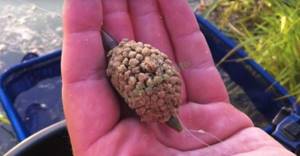
- Method feeders have good aerodynamic characteristics and fly confidently over long distances.
- It is easier for the fisherman to regulate the amount of bait; here he is not as limited by the dimensions of the feeder as in the case of mesh ones. He can even stick a thick ball of bait onto a light 20-gram feeder, so that its weight increases sharply, and the casting distance increases accordingly.
Unfortunately, on rivers with strong and medium currents, their advantages turn into disadvantages.
How and what to feed carp when fishing with a feeder
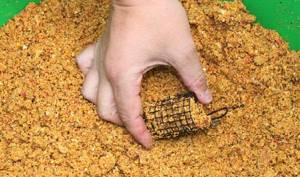
It is necessary to feed the carp. This fish loves to eat a lot, so it constantly moves around the water area in search of food. With the help of tasty and aromatic food, you can attract it to the fishing area and keep it there for a long time until a bite occurs.
The bait mixture can be factory-made or home-made. Store-bought foods are developed by famous athletes, are balanced, consist of a variety of ingredients that increase their nutritional properties, and are endowed with certain aroma and mechanics.
You have to make homemade bait yourself from available products. The fisherman can be creative and create his own mixture, focused on specific fishing conditions. Homemade food contains various cereals, breadcrumbs, spices, honey, peas, etc.
Methods of feeding bait
You can feed the fishing point in different ways. It depends on the fishing distance:
- You can throw the mixture short by hand, forming several balls the size of a tennis ball.
- At medium distances, special slingshots, carp rockets and feeders are used.
- At long distances, a radio-controlled bait boat and capacious weighted feeders are used.
Before starting fishing, a starting feeding must be done to create a spot on the bottom, where the equipment is then thrown.
Composition of mixtures and aromatics
Carp bait mixtures are made from various ingredients. It is based on porridges and cereals, for example, corn, semolina, barley. Biscuit, bran, flour, breadcrumbs, ground seeds or crushed nuts can also be added to the composition.
Advice: You need to be careful with flavorings, otherwise you can completely ruin the bait mixture, discouraging the carp from pecking.
Various natural attractants are used as flavoring agents - spices, seasonings, and other ingredients with a strong odor and taste:
- cinnamon;
- anise;
- fennel;
- fresh or dried berries;
- honey;
- sugar or powdered sugar.
In addition to dry flavors, liquid attractants can be added to the mixture.
A simple recipe for catchy homemade bait
All ingredients for homemade bait are prepared at home before going fishing. Already on the shore they are mixed with each other. Moisten with water to obtain the desired consistency and viscosity; if necessary, add soil or sand taken directly from the reservoir.
A simple but very effective recipe for carp food consists of:
- semolina;
- ground corn;
- fresh corn;
- breadcrumbs;
- corn flour.
All components are mixed directly on the shore and moistened with water. The advantage of this bait is that the fisherman does not need to cook or process anything at home. Additionally, dry or liquid attractants can be added to the mixture.
Lures for feeder carp fishing
The main bait for catching carp on a feeder is boilies. They are used on a hair rig or attached directly to a hook. Of the plant baits, fishermen use:
- canned corn or peas;
- boiled potatoes;
- parboiled wheat;
- dough;
- bread crumb.
Recommended reading: Flies for catching grayling
Corn, peas, wheat are placed on the hook in several pieces. Roll the dough and bread crumb into balls with a diameter of 5–15 mm. Vegetable baits work in the summer, late spring and early autumn.
You can also catch carp on a feeder using animal bait. This:
- earthworm or dungworm;
- larva of a caddisfly or other semi-aquatic insect;
- bloodworm;
- maggot.
The best period for animal baits is autumn, early spring. In summer they are inferior to baits, but they are worth a try if the carp is reluctant to bite. Sometimes it makes sense to combine baits.
Equipment method installation methods
Blind installation of equipment
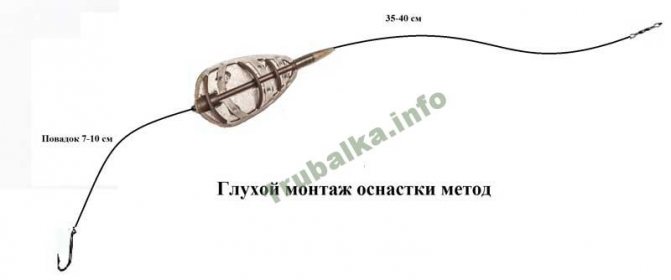
Blind installation of equipment method
Self-cutting mounting method, great for fishing with several rods. When biting, the fish makes a jerk and is caught under the weight of the feeder. As a base, we take a fishing line 0.25-0.35 mm thick, depending on the trophy, and thread it through the body of the feeder. Then at the extended end we make a small loop using a figure eight knot. In order for the knot to tighten better, we wet it. Then we thread the connector through the fishing line and attach the swivel using the noose loop. Then we pull the connector onto the swivel. Now we pull the fishing line so that our swivel and connector fit firmly into the body of the feeder. A leash 7-10 cm long is attached to the swivel.
We retreat 35-40 cm from the feeder and knit a figure eight loop; using a noose, we attach a swivel to it. It will connect our rig to the main line.
When installing equipment, some athletes use leadcore instead of monofilament - a braided cord with a lead core inside. Thanks to this, your equipment is not so prone to twisting, is perfectly sunk on the bottom and does not scare the prey, causing less injury to the fish.
Feeder equipment inline method
Sliding equipment (inline) is used for catching cautious fish, as well as on days when they are inactive, because when the fish bites there is no need to move the feeder.
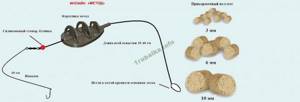
Inline method
To mount this gear, we use a monofilament fishing line of the same diameter as for the blind one, the length of the entire equipment is about 40 cm. We knit a swivel to the edge of the fishing line, and then the main fishing line will be knitted to it. then we thread a bead or silicone stopper through the opposite end; their task is to prevent the knot from hitting the feeder. After we thread the feeder, again we pass a bead or stopper and knit a swivel, the bead and stopper are selected with such a diameter so that they sit tightly on the fishing line and do not wander. The rubber stopper can be pulled onto the swivel. In this case, the size of the bead or stopper should not allow the swivel to enter the body of the feeder. Then we knit a leash 7-10 cm long to the swivel. The difference from the blind installation is that the equipment will slide freely along the fishing line.
Carp rig method for feeder
Here we will use flat-method feeders with feeder rubber ; you can buy them with rubber already installed on the feeder, or you can do it yourself.

Method-on-carp
Feeder Gum or Power gum is used for these purposes. We take an elastic band and attach a swivel to one edge using a figure eight knot, then thread the cambric and pull it onto the knot. Then we measure out the segment, as shown in the figure, the rubber at this moment should not be stretched, then we cut off the excess, skip the feeder and knit a swivel. If you did everything correctly, your feeder rubber will not protrude from the body of the feeder. Then, on the side where we have the cambric, we knit a leash 7-12 cm long, and on the opposite side, we knit the main line.
If there is no rubber, then install a 10 m shock leader made of monofilament with a diameter of 0.4 mm. The main line is also a monk 0.25-0.3 mm (we also use the same diameter when fishing with rubber). Then you do a dead-on or in-line installation. The thickness of the leash is 0.02 mm less than the diameter of the main line. When fishing for carp, it is recommended to use hair bait.
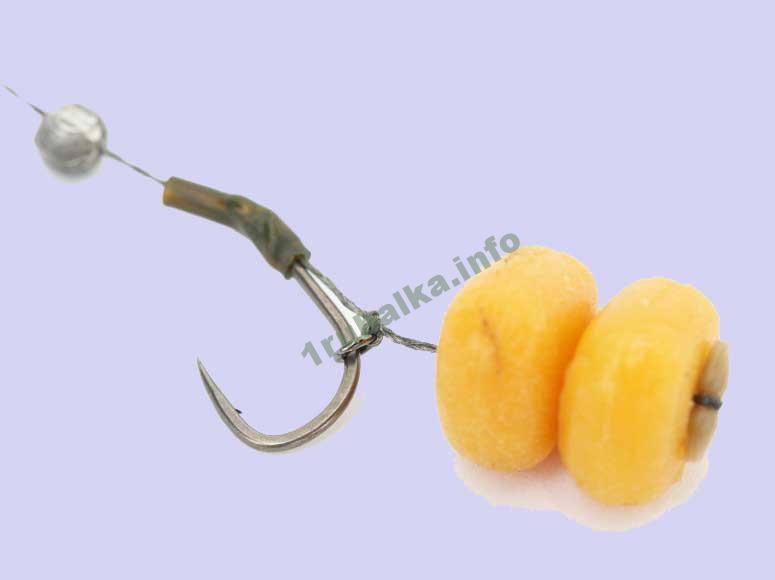
Hooks No. 12 - No. 16 according to the international classification.
Choosing a place to catch carp with a feeder

Despite the fact that most reservoirs have an almost flat, silted bottom, you must try to find some changes in the topography or changes in the structure of the bottom. This can be done either using a marker float or by “probing” the bottom with a weight.
Make the first maximum cast. Fix the line on the clip and begin to pull, counting the turns of the handle. Any changes in terrain will be reflected in the hand. Where there is a delay in movement, there is probably an obstacle or edge. We put a mark on the fishing line with a regular marker. Cast again and again until it hits the hand, or onto the quivertip. And so 5-6 times. If the marks approximately match, then you have found what you were looking for.
We put a regular rubber band on the spool and fix the casting distance with it. We pull out the line from under the clip, because anything can happen in the process of catching carp, but from under the elastic, the carp is able to tighten the line.
Choosing a feeder
The best method for installing equipment is flat feeders. It has a flat lead weight on the bottom, plastic ribs on top and angular protrusions for better fixation of the bait. The design of this feeder is balanced so that it rests on the bottom with the bait up and the sinker down. The hook is either hidden in the bait itself, and you get a kind of nipple, or it is located outside.
You must choose a feeder carefully, since some feeders are designed only for solid installation.
In order to properly equip the feeder with bait, special molds ( molds ) are used. Many branded feeders come complete with molds; if not, then when purchasing, choose those feeders that fit the molds available in the store. Well-known manufacturing companies Browning, Technocarp, Preston, Flagman, Drennan, Avid Carp, Gardner, Korda, Korum . A good option in terms of price-quality ratio would be feeders from VEGAS.
Also, the rigging method involves the use of frame feeders and spring feeders. Read more in the article feeder method.
Catching Carp on Feeder | Common Newbie Mistakes
The technique and tactics of Carp fishing are quite difficult. Often, after spending a lot of time searching for fish, the result leaves much to be desired. The main thing in carp fishing is not to give up.
Experienced carp anglers spend 3-4 days to select the optimal baits, baits and flavors.
As a reward for their efforts, they will almost always get the desired result. So in Carp fishing, patience is not the last thing.
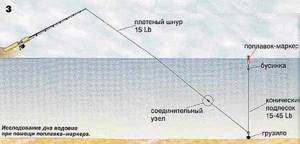
Carp are more often found in standing water, next to reed thickets. Prefers to hide in small dumps and pits.
Beginners often make the mistake of starting to look for carp far from the shore. Sometimes carp prefer the coastal zone.
To better know the Bottom Relief of the Reservoir you are fishing on, you need to tap the bottom with a marker rod.
Such a rod will not only help you recognize the bottom topography, but will also help you mark the point that we will feed in the future.
For ease of fishing, it is better to place all Tools, Baits and Groundbaits next to you, so that you are less distracted when fishing.
Each feeder rod has replaceable tips. They vary in rigidity and sensitivity.
The choice of tip depends on the Weight of the Feeder, as well as on the size of the fish you are going to catch.
Also, each Feeder has a Test. It is indicated in either Grams or Ounces. Test Rods should also be selected based on their Feeder Weight and Fish Size.
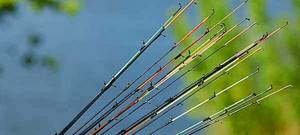
Bait and bait
The bait is made quite viscous and dense, but at the same time it must disintegrate well on the bottom, otherwise it will lie in a lump on the bottom, not arousing interest. As a guide, the bait should completely empty the feeder after 15 minutes. You can achieve the required viscosity by moistening the bait (if you don’t add enough water, it’s loose; if you overfill, it’s viscous), adding water portionwise. You shouldn’t soak all the bait at once, leave a little so that you can make adjustments. If you fish with a nipple, then your bait should become a homogeneous mass, with properties reminiscent of wet clay (effective for catching large fish in wild reservoirs where there is a lot of small fish). In this case, do not forget to add flavorings and attractants to the bait, because such bait is visually less noticeable, since it does not generate dust and has a small food stain. Due to the fact that the feeder is open, it is very convenient to use flavoring sprays, especially if you have several types.

You can buy specialized method bait in the store, buy regular bait for white fish and add an adhesive component (for example molasses) or make it yourself. Here are some interesting recipes:
Recipe No. 1
- Pounded wheat bread – 300 grams;
- Cottage cheese 150 grams;
- Cake 150 grams
- Finely ground peas – 150 grams;
- Ground garlic;
- Hemp oil.
Recipe No. 2
- Breadcrumbs - 1000 grams;
- Corn flour 200 grams;
- Semolina 300 grams;
- Ground seeds 100 grams;
- Hemp 100 grams;
- Wheat bran 100 grams;
- Powdered milk 15-20 grams.
When fishing with a rig method, there is no need to do a massive starting feeding; 4-5 casts of the feeder are enough. Re-throw the feeder no more often, once every 15 minutes.
When fishing with a rig method, it is better if you use a large bait: a bunch of worms or maggots, corn, peas, various boilies, “ottomans”, soft pellets. In this case, pellets are often added to the bait itself.
